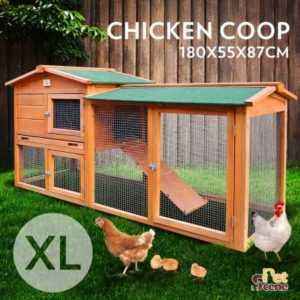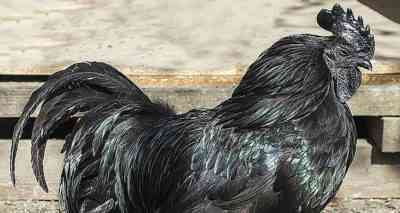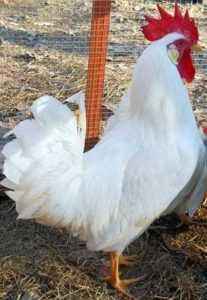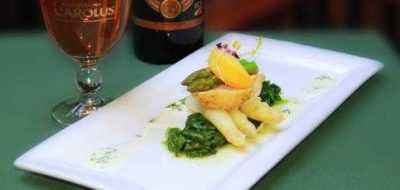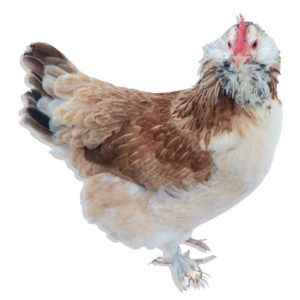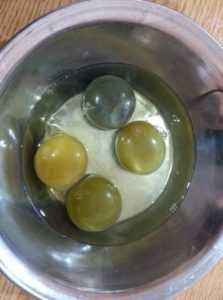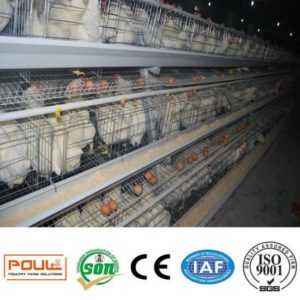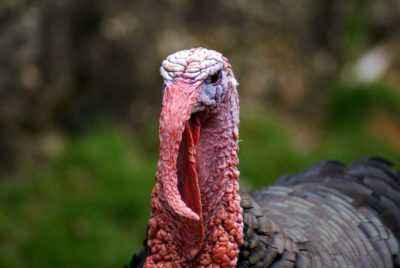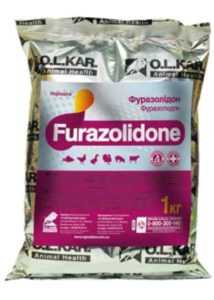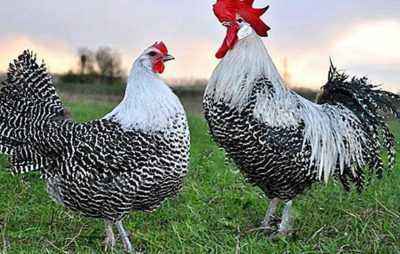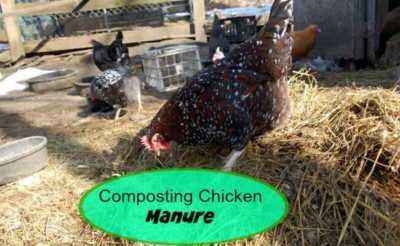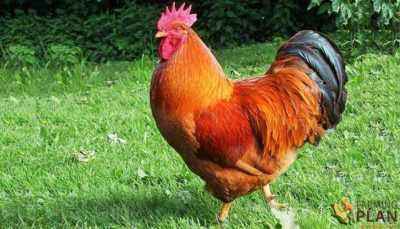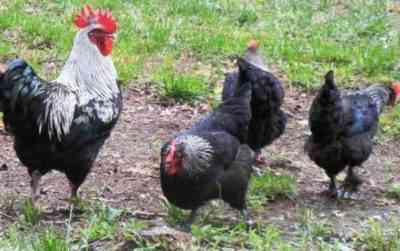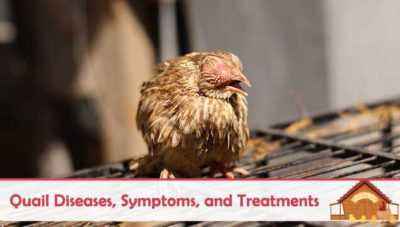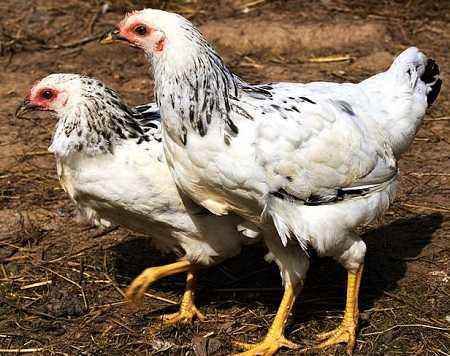Dominant chickens are a highly productive breed of laying hens, whose homeland is the Czech Republic. By the number of eggs, it surpasses such popular breeds as Leggorn, Sussex, Cornish, Loman Brown. However, some of them participated in its breeding. Breeders managed to achieve not only high productivity. These chickens are the owners of a beautiful, almost artistic style of color. Birds get great reviews.It is not difficult to find an incubation egg and chickens on the market, they are sold in any quantities.
- Description of the breed
- Productivity of the breed
- Species of the breed
- Dominant speckled D 959
- Dominant partridge D 300
- Dominant tricolor D 301
- Dominant black D 109
- Dominant black D 149
- Dominant Sussex D 104
- Dominant Sussex D 304
- Dominant Leggorn D 229
- Dominant red D 853
- Dominant yang arny D 843
- Dominant blue D 107
- Dominant brown D 102 and D 192
- Dominant red striped D 159
- Dominant red striped D 459
- Advantages of the breed
- Features of the content
- Feeding birds
- Breeding chickens

Hens Dominant
Description of the breed
The Czech selection school is not the most famous in the world, but it has enough scientific potential. The Czechs managed to create a great hybrid. The task was to raise chickens with high productivity, disease resistance, unpretentiousness in feeding and keeping.In addition, breeders have tried to consolidate the beautiful plumage in the genome. To achieve such goals, the following breeds began to cross:
- Rhode Island ;
- Leghorn ;
- Plymouthrock ;
- Sussex ;
- Cornish .
The goals were fully achieved. The Czech dominant has become famous all over the world. He was even included in the Swiss program for the production of organic products. Video, photos and descriptions of layers of Dominant can be found on the site. Here are typical signs of the breed:
- The body is massive, large, with a red “face.”
- The head is small, the scallop and earrings are bright scarlet, the males have a little more than the chickens.
- The wings fit snugly on the body.
- The legs are short, light yellow, covered with lush feathers, which makes the layers look squat.
- The plumage is colorful , depending on the species.
Hens of the Czech breed Dominant can live and rush in any conditions. Even in the north, where many other laying hens lose their productivity, Dominants adapt perfectly. They have a very strong immunity, to most chicken pathologies the birds are not sensitive, some diseases are only tolerated in a mild form. Studying all the symptoms of pathologies can take a lot of time, so if you have problems, it is better to contact the veterinarian.
Productivity of the breed
The productivity of chickens of the Dominant breed is very high.Even with poor feeding and in adverse conditions, they continue to lay eggs well. In addition, males and hens weigh quite a lot, which is uncharacteristic for the egg direction. Here is a description of these amazing laying hens:
- the annual number of eggs is 300 or more;
- the weight at the age of 4.5 months is 2.5 kg;
- the survival rate of chickens is 94-99%, the hatching egg is well fertilized;
- average daily feed consumption is 120-125 g, average annual consumption is 45 kg;
- eggs weigh an average of 70 g .
Hens begin to hatch at the age of 5 months, reaching a maximum of one and a half years. At about 3 years old, some of them are sent for meat, leaving only the best specimens. Productivity decreases slightly during the molting period, which begins in late autumn and lasts about two months. The average life span of Dominant chickens is 9-10 years, but keeping birds for such a long time is unprofitable, unless they are valuable individuals intended for the tribe. This primarily concerns roosters.
There are different types of laying hens of the Dominant breed. The productivity of these crosses can vary both for the better and for the worse. In addition, varieties have different colors of plumage. All Dominants are sold. Before you buy an incubation egg or chicken, you need to carefully familiarize yourself with all the lines. Details of the different crosses are described below.
Species of the breed
Based on layers of Dominants, different crosses were bred. They differ in terms of productivity, appearance, plumage color. A common feature of all crosses is high egg production, good tolerance to low temperatures and other adverse conditions, and resistance to infections. All who decided to get this breed, even talk of not replacing it. Below is a brief description and description of all varieties:
Speckled dominant D 959
The hens of the Speckled dominant breed have cuckoo, black and white plumage. They adapt perfectly in cold climates, rarely get sick. The eggs are white or cream in color. It is easy to determine the sex of Dominant mottled cross. Sex, black and white chicken overgrows with feathers earlier than roosters. Egg production is defined as good, reaches 300 pieces per year, average egg weight is 65 g.
Partridge dominant D 300
Birds of this species became popular because of the beautiful color feathers. They shimmer with brown and gold colors, like the Italian gold breed and brown leggorn. Reminiscent of the plumage of wild birds. The egg production of this hybrid is not too high, 25-265 pieces per year, therefore partridge layers are bred in private farms, and partly as decorative birds .
The dominant of the tricolor D 301
The dominant of the tricolor D 301 was obtained by crossing tri-colored leggorn with brown leggorn. The result was beautiful birds with a very interesting plumage. It shimmers with red, gold and brown tones. Colored hens have not too high egg production, about 20-250 pieces per year, because their cultivation and sale is practiced on private farms, the poultry farm is interested in higher productivity.
Dominant black D 109
The dominant black D 109 is characterized by very high immunity, vitality reaches 100%. The color of the feathers of chickens and roosters is black, the earrings and scallops are bright. Layers Dominant black cross D 109 – very good hens and mothers. Their productivity is 300-315 testicles per year weighing up to 70 g. The weight of females reaches 2 kg, males – 3 kg. This cross has a wonderful character, the black bird is absolutely not shy, he is happy to make contact.
Dominant is black D 149
Like the previous cross, D 149 has bright black plumage, which is why it is valued in private households. These chickens are bred to get environmentally friendly products. They are distinguished by their peaceful nature, good adaptability when kept in any conditions. The black laying egg produces 290-300 testicles per year with an average weight of 62 g and a dark brown shell.
Dominant Sussex D 104
the dominant Sussex adapts well to cold climates, the viability of birds is 98%. The color of the feathers of this Dominant is white with a silvery sheen, only the head and tail are dark gray in color. It rushes well, gives 290-310 testicles per year, with good nutrition this figure rises to 320 pieces. Maximum egg production is observed at 18 months. Roosters weigh about 2.5 kg, chicken – 1.6-1.8 kg. In this cross, as in others, it is easy to determine the male and female type of chickens by the speed of plumage.
Dominant Sussex D 304
In appearance, this cross resembles D 104. The feathers of the birds are white, and the head and tail are black. Differs from the previous cross in lower egg production rates. In a year, females produce 25-260 testicles weighing about 60 g, with a white shell. The mass of the birds themselves is 1.5-2 kg at the age of 18 months. This cross is bred most often in household plots and in small private farms.
Dominant Leggorn D 229
This cross dominant has a white feather color. It is characterized by strong resilience, in the region of 96-97%. Layer productivity is also high – 305-310 testicles per year. The birds weigh a little, about 1.3-1.5 kg. Good egg production at low feed costs made white dominants very beneficial for breeding. They are most often found on industrial farms. The incubation egg of this hybrid may cost a little more than the rest.
Dominant red D 853
Red Dominant is one of the most unproductive crosses in this breed. Chickens start to run at 23 weeks, the average is 250-270 testicles per year, sometimes less. The plumage is very beautiful, red with brown. Hens got this color from their parents, the brown and red Rhode Islands. Laying red Dominant is unpretentious in maintenance, well suited for breeding near a private house and in small farms.
Amber dominant A 843
Birds have a beautiful amber plumage, calm and peaceful temperament. The egg production of the hybrid is 300-310 pieces per year. The average weight of one egg is 62 g, a brown shell. The weight of the laying hens is about 1.5 kg, of the cockerels 2 kg. Vitality reaches 93-96%. The average feed consumption for this cross country is 120 g per day or 45 kg per year.
Dominant blue D 107
Dominant blue D 107 – a very beautiful bird, reminiscent of color his plumage of the Andalusian chickens, looks very beautiful in the photo. It adapts well to harsh climatic conditions, surpasses black cross in vitality. Chickens can carry about 300 testicles per year, one weighs 60 g. Roosters weigh 3 kg, adult chickens 2.15 kg.
The dominant is brown D 102 and D 192
The dominant brown D 102 is one of the most productive varieties. Egg production reaches 320 pieces per year, the average egg weight is 62 g.The mass of the birds themselves is small, roosters weigh about 2 kg, chicken – 1.4 kg. The brown cross Dominant D 102 is one of the most popular in homesteads and industrial farms. It is distinguished by strong immunity, good adaptation to low temperatures. Cross D 192 has lower productivity, laying hens produce 300-305 eggs per year. Compared to other breeds, this is not such a significant drawback.
Red striped dominant D 159
The cross red striped dominant came from crossing a Rhode Island rooster with red plumage and hens the same species with brown feathers. As a result, we got birds of an interesting color, in which both parental shades are combined. Laying striped Dominants produce up to 305-310 testicles per year, their weight is a little more than 60 g.
Dominant red striped D 459
Cross Dominant red striped D 459 was obtained by crossing roosters of the genus Island and chickens of Sussex. The result was beautiful birds that have a motley, red-brown color. Their productivity is high, females carry 300-305 eggs per year, with a brown shell and weighing 60-65 g. This value can increase with balanced feeding.
Advantages of the breed
Layers of the breed Dominant won the hearts of their owners for a reason. The years of work of Czech breeders were not in vain. Advantages of crosses are difficult to overestimate.Here are some of the most significant advantages of this species:
- High egg production of chickens (from 300 to 320 pieces throughout the year).
- Birds begin to hatch at 4-5 months and very soon reach the threshold of its 50% productivity.
- Hens dominate hatching even when daylight hours are reduced, although artificial illumination can increase egg production.
- The breed can be kept both in cells and in free walking.
- The chickens are very viable, 94-99% of young animals survive.
- The breed of hens Dominant is undemanding to yokes, the birds do not need any special supplements or mixture, it is suitable for all standard domestic chicken meal.
Deficiencies in layers Dominant virtually none. Sometimes farmers note that in winter, hens become aggressive, peck each other and their own eggs. This is due to a lack of vitamins and minerals. Correcting this behavior is simple: you need to balance the diet, introduce vitamin supplements, chalk, crushed shells and other useful substances.
Content Features
Dominant chickens are completely unpretentious in content They can be bred in cages , poultry houses with an aviary or on free grazing. It is noted that cross-country productivity increases if birds are able to walk in the fresh air, so the last two options are more acceptable.
Which requirements for the house? This may be the most common barn, as with other poultry. But to increase productivity, it is worthwhile to adhere to the following rules when arranging a room:
- No more than 4-5 birds should live on 1 m² of area.
- It is better to make the floor wooden, put litter on the boards from straw or peat.
- For the prevention of disease, the litter is treated with slaked lime, changed as it becomes soiled.
- Heating for the chicken coop is not required, but before the winter, it is necessary to carefully cover all the cracks and insulate the external walls.
- If in the region the temperature drops below -10 ° C, you should consider temporary heating of the house. Even hardy chickens such as Dominant can freeze.
- It is advisable to equip a place for walking at the rate of 3-4 m² per individual. It can be an aviary or a fenced yard.
- The poultry house should have separate feeders for grain, wet food and a container for water.
- They clean the house 2-3 times a month, perform general cleaning once every six months.
Layers of the dominant breed fly poorly, they do not need a corral with a high fence. This cross tolerates low temperatures better than high ones, so you need to make sure that in the summer the house is not too hot, especially with a cellular content. Aviary is best equipped in a shaded place, from the north or east side. The coop is regularly ventilated, with a large population it is best to install an extractor hood. They also make sure that there are no drafts in the room: this can undermine the health of birds and reduce egg production.
Feeding birds
Feeding Dominant chickens at home is simple. Even if the food is of poor quality, the egg production of birds is maintained.But it is not possible to achieve maximum productivity indicators in such conditions, therefore it is better that the diet be different and balanced. The following products are included in the food:
- grain of wheat, barley, oats;
- wheat bran;
- meal from soy or sunflower;
- meat and bone meal;
- boiled potatoes;
- peas;
- sugar beets;
- reverse;
- animal fats;
- grass meal;
- vitamin complexes.
In the summer, green chickens can feed themselves. Three times a day they are given grain and moist mash of boiled vegetables. You can also feed birds during this period with zucchini, pumpkin, plant tops, and cleanings. In winter, hay or silage is necessarily added to the feed. It is important in cold weather to increase the protein content in the diet. Chickens are given peas and hay from legumes, reverse, meat broth.
Be sure to put a separate container with water in the house, which should always be clean and fresh. Nearby put a bowl with crushed shells, pebbles. These substances contribute to the grinding of coarse grain feed in goiter, make up for the lack of minerals. For the eggshell to be strong, the birds need calcium and vitamin D, therefore, fish oil, chalk can be included in the food. In late winter and early spring, to increase the number of eggs, add premix or other vitamin complexes to the diet.
Breeding chickens
To breed dominant chickens, you need to choose the right cross .If you grow birds in a personal plot, any variety is suitable. For business industrial breeding, it is best to choose:
- Sussex D 104;
- Black D 109;
- Speckled D 954;
- Blue D 107;
- Brown D 102.
The instinct of hatching of chicks in hybrid birds is poorly developed (with the exception of some crosses), but the offspring survive well, therefore, on an incubation egg it is better to plant on other chickens (for example, Loman Brown) or keep in an incubator. The percentage of hatchability is high, and the survival rate of chickens is good, even novices can cope with chicks. The incubation conditions for them are standard. If you follow the instructions, in 80-90% the result will be positive.
In the first days after the release of the chicks they are kept warm at a temperature of 28-30 ° C. Daily lower it by 1-2 degrees, until the figures of 18-20 ° C are reached. In the box where the chickens live, it should be clean and dry, the litter is changed daily. In order to prevent disease, vaccination is given to the chicks in the early days.
Feed the chickens after birth 6 times a day. They give a boiled egg, crumbly porridge, chopped nettle, quinoa, green onion. From 2-3 days you can add to the diet cottage cheese, bread. Be sure to add crushed shells, large sand, chalk to the feed to improve digestion of food. Special vitamin supplements come in handy. At 3-4 weeks, the chickens are taken outside, they gradually learn to look for food on their own.Dominant gains weight quickly, almost like a broiler. It starts to rush very early. It’s easy to distinguish between males and females: young females become feathered faster.
How much does a Dominant chicken cost? The average price is 250-350 rubles per individual, an incubation egg costs 20-30 rubles. You need to buy chicks and testes only from trusted manufacturers. If the company is reliable, then it must have a certificate. There are specialized farms selling chickens in Russia, Belarus, and Ukraine. When buying chickens, you must definitely check (not by word of mouth, but according to the documents) if they have all the vaccinations.
